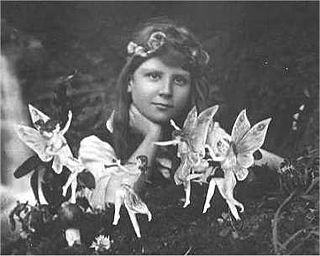
The Cottingley Fairies appear in a series of five photographs taken by Elsie Wright (1901–1988) and Frances Griffiths (1907–1986), two young cousins who lived in Cottingley, near Bradford in England. In 1917, when the first two photographs were taken, Elsie was 16 years old and Frances was 9. The pictures came to the attention of writer Sir Arthur Conan Doyle, who used them to illustrate an article on fairies he had been commissioned to write for the Christmas 1920 edition of The Strand Magazine. Doyle, as a spiritualist, was enthusiastic about the photographs, and interpreted them as clear and visible evidence of psychic phenomena. Public reaction was mixed; some accepted the images as genuine, others believed that they had been faked.

A fairy tale, wonder tale, magic tale, or Märchen is a folklore genre that takes the form of a short story. Such stories typically feature entities such as dwarfs, dragons, elves, fairies, giants, gnomes, goblins, griffins, mermaids, talking animals, trolls, unicorns, or witches, and usually magic or enchantments. Fairy tales may be distinguished from other folk narratives such as legends and explicit moral tales, including beast fables. The term is mainly used for stories with origins in European tradition and, at least in recent centuries, mostly relates to children's literature.

Neverland is a fictional island featured in the works of J. M. Barrie and those based on them. It is an imaginary faraway place, where Peter Pan, Tinker Bell, the Lost Boys and other mythical creatures and beings live. Although not all people who come to Neverland cease to age, its best known resident famously refused to grow up. The term is often used as a metaphor for eternal childhood, immortality, and escapism. The concept was first introduced as "the Never Never Land" in the theatre play Peter Pan, or The Boy Who Wouldn't Grow Up by Scottish writer J. M. Barrie, first staged in 1904.

"Hansel and Gretel" is a well-known German fairy tale recorded by the Brothers Grimm and published in 1812. Hansel and Gretel are a young brother and sister kidnapped by a cannibalistic witch living in a forest, in a house constructed of cake, confectionery, candy, and many more treats than are imaginable. The two children escape with their lives by outwitting her. The tale has been adapted to various media, most notably the opera Hänsel und Gretel (1893) by Engelbert Humperdinck. Under the Aarne–Thompson classification system, "Hansel and Gretel" is classified under Class 327.
"Little Red Riding Hood" is a European fairy tale about a young girl and a Big Bad Wolf. Its origins can be traced back to the 10th century by several European folk tales, including one from Italy called The False Grandmother, later written among others by Italo Calvino in the Italian Folktales collection; the best known versions were written by Charles Perrault and the Brothers Grimm. The story has been changed considerably in various retellings and subjected to numerous modern adaptations and readings. Other names for the story are: "Little Red Ridinghood", "Little Red Cap" or simply "Red Riding Hood". It is number 333 in the Aarne–Thompson classification system for folktales.

A changeling is a creature found in folklore and folk religion throughout Europe. A changeling was believed to be a fairy child that had been left in place of a human child stolen by the fairies. The theme of the swapped child is common in medieval literature and modernly reflects concern over infants thought to be afflicted with unexplained diseases, disorders, or developmental disabilities.

In Breton folklore, a Korrigan ([kɔˈriːɡɑ̃n] is a fairy or dwarf-like spirit. The word korrigan means "small-dwarf". It is closely related to the Cornish word korrik which means gnome. The name changes according to the place. Among the other names, there are korrig, korred, korrs, kores, couril, crion, goric, kornandon, ozigan, nozigan, torrigan, viltañs, poulpikan, paotred ar sabad...

In fairy tales, a fairy godmother is a fairy with magical powers who acts as a mentor or parent to someone, in the role that an actual godparent was expected to play in many societies. In Perrault's Cinderella, he concludes the tale with the cynical moral that no personal advantages will suffice without proper connections.

Titania is a character in William Shakespeare's play A Midsummer Night's Dream. In the play, she is the queen of the fairies. Due to Shakespeare's influence, later fiction has often used the name "Titania" for fairy queen characters.
In Swiss folklore, Jack o' the bowl is a helpful house spirit and variously described as a brownie or kobold.
Finette Cendron is a French literary fairy tale written by Madame d'Aulnoy.

Fairy forts are the remains of lios (ringforts), hillforts or other circular dwellings in Ireland. From (possibly) late Iron Age to early Christian times, the island's occupants built circular structures with earth banks or ditches. These were sometimes topped with wooden palisades, and wooden framed buildings. As the dwellings were not durable, in many cases only vague circular marks remain in the landscape. Raths and lios are found in all parts of Ireland.

T2 or is a 2009 supernatural horror film produced and distributed by Star Cinema. The film stars Maricel Soriano. The film was directed by Chito Rono, director of the critically acclaimed film Sukob.
Cnoc Meadha is a hill west of Tuam, County Galway, in Ireland.

A Fairly Odd Christmas is a 2012 television film that is the sequel to the 2011 live-action TV film A Fairly Odd Movie: Grow Up, Timmy Turner! and the second live-action adaptation of the Nickelodeon animated television series The Fairly OddParents. This was Drake Bell's second appearance in a Christmas-themed Nickelodeon film, the first being Merry Christmas, Drake & Josh.

Marble Caves is a cave in Crimea, at the lower plateau of Chatyr-Dag, mountainous massif. It is a popular tourist attraction being one of the most visited caves in Europe.
Gunnergate Hall was a mansion house with grounds in the south of Middlesbrough in North Yorkshire, England.












